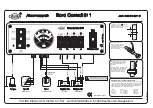
Keep a record for at least one month and record the type of driving (city
or highway). This will provide an accurate estimate of the vehicle’s fuel
economy under current driving conditions. Additionally, keeping records
during summer and winter will show how temperature impacts fuel
economy. In general, lower temperatures give lower fuel economy.
Driving style — good driving and fuel economy habits
Give consideration to the lists that follow and you may be able to change
a number of variables and improve your fuel economy.
Habits
•
Smooth, moderate operation can yield up to 10% savings in fuel.
•
Steady speeds without stopping will usually give the best fuel economy.
•
Anticipate stopping; slowing down may eliminate the need to stop.
•
Sudden or hard accelerations may reduce fuel economy.
•
Slow down gradually.
•
Driving at reasonable speeds (traveling at 88 km/h [55 mph] uses 15%
less fuel than traveling at 105 km/h [65 mph]).
•
Using the air conditioner or defroster may reduce fuel economy.
•
Resting your foot on the brake pedal while driving may reduce fuel
economy.
Conditions
•
Carrying unnecessary weight may reduce fuel economy.
•
Fuel economy may decrease with lower temperatures during the first
12–16 km (8–10 miles) of driving.
•
Flat terrain driving improves fuel economy over hilly roads.
•
Transmissions give their best fuel economy when operated in the top
cruise gear and with steady pressure on the accelerator.
•
Close windows for highway driving.
Maintenance and care
191
Содержание F-650 2001
Страница 7: ...Instrumentation 7...
















































